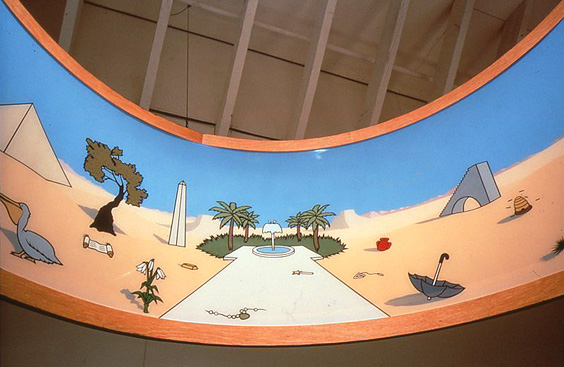The Pantocrator’s Circus
(1990)Wall Text from the Adeline Kent Award Exhibition at the San Francisco Art Institute
This installation consists of three parts: The Seven Deadly Sins, The Four Last Things, and The Pantocrator.
The Pantocrator's Circus was inspired by and structured after The Tabletop of the Seven Deadly Sins and the Four Last Things by Hieronymus Bosch. The Bosch painting follows the medieval tradition of the representation of these icons of sin and redemption illustrated as narrative and vignette.
The version that David created transforms the tabletop format into a representation of a Nineteenth Century sideshow or circus. The Seven Deadly Sins are represented as a series of funhouse mirrors with accompanying figures, titled in Latin, in keeping with the tradition of these paintings from the early Renaissance, but the message of each sin has been transformed into a double message that of the equation of disease with morality.
In these new interpretations of sin/as punished morality, the artist tried to express how the popular imagination has not changed much in 500 years. As a person with AIDS, he is acutely aware and highly critical of any physical condition being negatively moralized. The follies represented in these paintings are not simply the follies of sin, but of the absurdity of even discussing the two issues simultaneously.
In the cycloramas, the four alternative universes of Christian apocalyps (Death, The Last Judgment Heaven and Hell) are used as background to the visual inclusion of world symbols of the same concepts. For instance, the cyclorama exhibited here, Caelum (Heaven) displays Landscape, season, time of day as well as including a variety of symbolic objects, plants and animals that represent or are included in the concept of Heaven for all major cultures and religions. These figures scattered about the landscape like trash, also serve to remind us of the basically universal nature of these symbols and mythical structures.
In a way, they represent a model of how humans see the world, blocked off from the real world, by our representations, we can spin around on these pedestals and pretend that the world is decipherable.
This installation consists of three parts: The Seven Deadly Sins, The Four Last Things, and The Pantocrator.
The Pantocrator's Circus was inspired by and structured after The Tabletop of the Seven Deadly Sins and the Four Last Things by Hieronymus Bosch. The Bosch painting follows the medieval tradition of the representation of these icons of sin and redemption illustrated as narrative and vignette.
The version that David created transforms the tabletop format into a representation of a Nineteenth Century sideshow or circus. The Seven Deadly Sins are represented as a series of funhouse mirrors with accompanying figures, titled in Latin, in keeping with the tradition of these paintings from the early Renaissance, but the message of each sin has been transformed into a double message that of the equation of disease with morality.
In these new interpretations of sin/as punished morality, the artist tried to express how the popular imagination has not changed much in 500 years. As a person with AIDS, he is acutely aware and highly critical of any physical condition being negatively moralized. The follies represented in these paintings are not simply the follies of sin, but of the absurdity of even discussing the two issues simultaneously.
In the cycloramas, the four alternative universes of Christian apocalyps (Death, The Last Judgment Heaven and Hell) are used as background to the visual inclusion of world symbols of the same concepts. For instance, the cyclorama exhibited here, Caelum (Heaven) displays Landscape, season, time of day as well as including a variety of symbolic objects, plants and animals that represent or are included in the concept of Heaven for all major cultures and religions. These figures scattered about the landscape like trash, also serve to remind us of the basically universal nature of these symbols and mythical structures.
In a way, they represent a model of how humans see the world, blocked off from the real world, by our representations, we can spin around on these pedestals and pretend that the world is decipherable.




